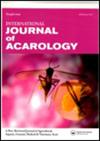以不同苹果品种为材料饲养霜叶螨(Trombidiformes:Tetranychidae)为食的风铃夜蛾(中柱头目:Phytoseidae)的生活表和捕食效率研究
IF 1
3区 农林科学
Q3 ENTOMOLOGY
引用次数: 1
摘要
摘要在实验室条件下,研究了以Kohanz Golab、Imperial Gala、Lebanon Red和Granny Smith四个苹果品种为试材的霜纹始叶螨若虫为食的斑叶夜蛾(Phytoseidae)的生活表参数和捕食率。雌性未成熟期发育时间最长的是Kohanz Golab,最短的是Smith奶奶。产卵量从Golab Kohanz的27.28个卵到Granny Smith的41.98个卵不等。Smith奶奶(0.254天-1)和Kohanz Golab(0.136天-1)分别获得了最高和最低的内在增长率(r)。Kohanz Golab、Imperial Gala、Lebanon Red和Granny Smith所有未成熟阶段的总猎物消耗量分别为36.93、29.93、27.36和21.30只。成年雌性对Kohanz Golab的总猎物消耗量为424.70±24.41只,对Imperial Gala的327.39±18.50只,对Lebanon Red的289.77±17.42只,对Granny Smith的218.50±14.64只。该捕食者对霜霉病抗性品种(Kohanz-Golab)的繁殖力和固有增长率最低,总寿命最长,这表明综合利用抗性品种和植物寄生螨防治蜘蛛螨需要更多的研究。本文章由计算机程序翻译,如有差异,请以英文原文为准。
Study of life table and predation efficiency of Typhlodromus bagdasarjani (Mesostigmata: Phytoseiidae) fed Eotetranychus frosti (Trombidiformes: Tetranychidae) reared on different apple cultivars
ABSTRACT The life table parameters and predation rate of Typhlodromus bagdasarjani Wainstein & Arutunjan (Phytoseiidae) fed on Eotetranychus frosti (McGregor) (Tetranychidae) nymphs reared on four apple cultivars Kohanz Golab, Imperial Gala, Lebanon Red, and Granny Smith were studied under laboratory conditions. The longest developmental time of immature stages in females was observed on Kohanz Golab, and the shortest one was on Granny Smith. The fecundity ranged from 27.28 eggs on Golab Kohanz to 41.98 eggs on Granny Smith. The highest and lowest intrinsic rate of increase (r) were obtained on Granny Smith (0.254 day-1), and Kohanz Golab (0.136 day-1), respectively. The total prey consumption by all immature stages on Kohanz Golab, Imperial Gala, Lebanon Red, and Granny Smith was 36.93, 29.93, 27.36, and 21.30 prey, respectively. The total prey consumption by adult females was 424.70±24.41 prey on Kohanz Golab, 327.39±18.50 prey on Imperial Gala, 289.77±17.42 prey on Lebanon Red, and 218.50±14.64 prey on Granny Smith. The lowest fecundity and intrinsic rate of increase as well as the longest total life span of the predator on the resistant cultivar (Kohanz Golab) to E. frosti showed that integrated use of resistant cultivars and phytoseiid mites for control of spider mites needs more investigations.
求助全文
通过发布文献求助,成功后即可免费获取论文全文。
去求助
来源期刊
CiteScore
2.20
自引率
9.10%
发文量
60
审稿时长
6-12 weeks
期刊介绍:
The International Journal of Acarology has a global readership and publishes original research and review papers on a wide variety of acarological subjects including:
• mite and tick behavior
• biochemistry
• biology
• control
• ecology
• evolution
• morphology
• physiology
• systematics
• taxonomy (single species descriptions are discouraged unless accompanied by additional new information on ecology, biology, systematics, etc.)
All submitted manuscripts are subject to initial appraisal by the Editor. If the English is not of a quality suitable for reviewers, the manuscript will be returned. If found suitable for further consideration, it will be submitted to peer review by independent, anonymous expert referees. All peer review is single blind.

 求助内容:
求助内容: 应助结果提醒方式:
应助结果提醒方式:


